NPS Score: The Complete Guide
This is a complete guide to NPS Score.
It’ll show you:
- What Net Promoter Score is
- Why NPS score is such a big deal for businesses
- What sort of insights you can get from an NPS score
- What does a typical NPS survey looks like
- How to calculate your NPS score based on NPS survey results
- How to measure NPS score, and
- How to use NPS score to improve your business and the bottom line.
It’s a lot to cover, so let’s I guess, we should get started…
Why is the NPS score such a big deal?
In my career, I have seen so many supposedly amazing approaches to measuring customer satisfaction and loyalty since I started building products.
Remember this one, for example?
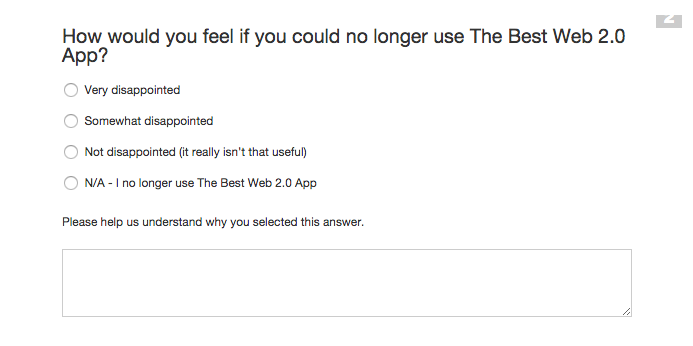
If I remember correctly, it was the first attempt to quantify such a seemingly impossible to measure metric as customer satisfaction.
And it worked. Well, to some degree, at least.
But when you look at their effectiveness, none of those methods ever came close to the NPS score, though, and that’s for several reasons:
- Net Promoter Score (NPS) is a simple metric to measure and analyze.
- NPS score delivers unmatched insights into customers’ attitudes toward a product or service.
- Not to mention that the NPS score is universally understood. You can easily share it with everyone across the organization, and they’ll all gain actionable insights from the score.
But…
NPS can also seem a little bit overwhelming at first.
It doesn’t often come across as a straightforward metric.
So, let’s simplify the concept of the NPS score…
What is the NPS Score (Net Promoter Score)?
When we talk about NPS (Net Promoter Score), we refer to a single metric used to measure customer experience, satisfaction, and loyalty.
Developed by Bain and Co in 2003, NPS is now used by countless companies who want to better understand how their customers perceive their products and services.
Actually, according to the data published in Fortune magazine, two-thirds of Fortune 1000 companies measure their NPS and rely on it to boost growth.
Two-thirds of 1000 top companies in the world. That says something.
I suppose that the vast popularity of NPS has a lot to do with two factors:
- The simplicity of NPS, and
- The incredible insights it delivers.
Let’s look at the simplicity first.
What NPS survey looks like
NPS is measured by what we call a single-question survey.
In short, it helps you evaluate a customer’s attitude towards a company or product with exactly that – just a single question.
It looks like this:
How likely are you to recommend [product or service] to a friend or colleague?
And here’s an example of a typical NPS survey widget:
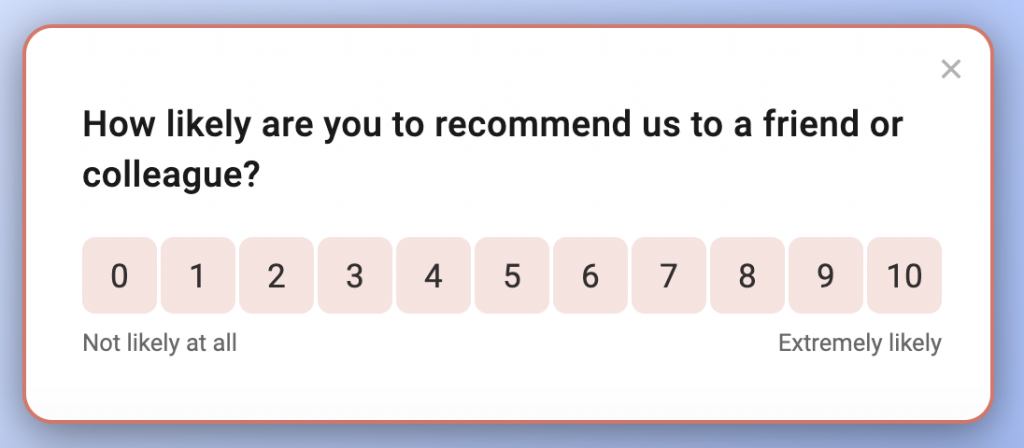
But that simplicity extends beyond just the survey format.
Customers also don’t have to do much to respond.
They voice their opinion by rating their referral likelihood on a scale of 0 to 10.
That’s it.
Based on their responses, you categorize customers into one of three categories, and based on that calculate the NPS score:
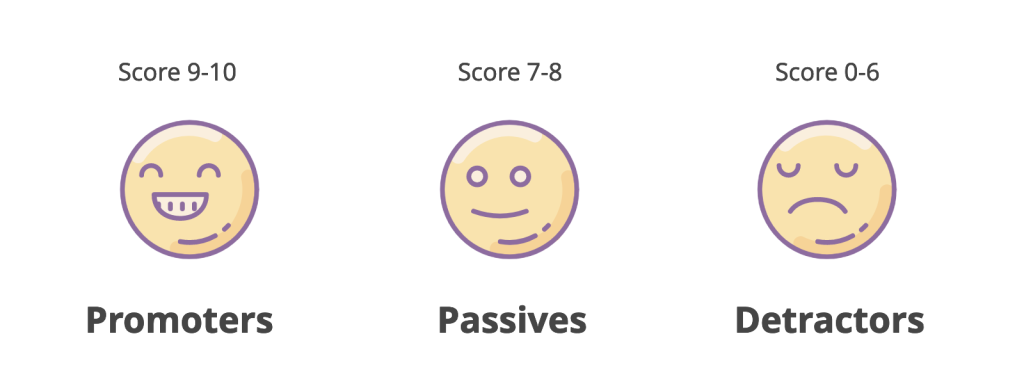
Promoters (scores 9-10)
- These customers rated their likelihood of recommending the company or its products with a score of 9 or 10.
- These are loyal customers, enthusiastic about your product. These people most likely can’t imagine living without it.
- Generate positive word-of-mouth and often contribute to product growth.
- Hard to sway by competitive offers.
- Great source of positive reviews and testimonials.
Passives (scores 7 – 8)
- These customers are certainly satisfied with your product or service but aren’t happy enough not to be swayed by competitive offers, should those arise.
- They also aren’t satisfied enough to feel comfortable telling others about you. Rarely generate any referrals or word-of-mouth.
Detractors (scores between 0 and 6)
- Unhappy customers.
- These people not only do not enjoy using your products but also are open to voicing their dissatisfaction.
- This group of customers is often responsible for generating negative word-of-mouth about your brand.
- Detractors are also ready to switch to a competitor and most likely, will do so.
How to calculate NPS?
NPS score is the difference between the number of detractors vs. promoters you have.
NPS score is the numerical value that represents the overall net promoter score of your company. You calculate it using a simple formula:
Total % of promoters – Total % of detractors = NPS Score
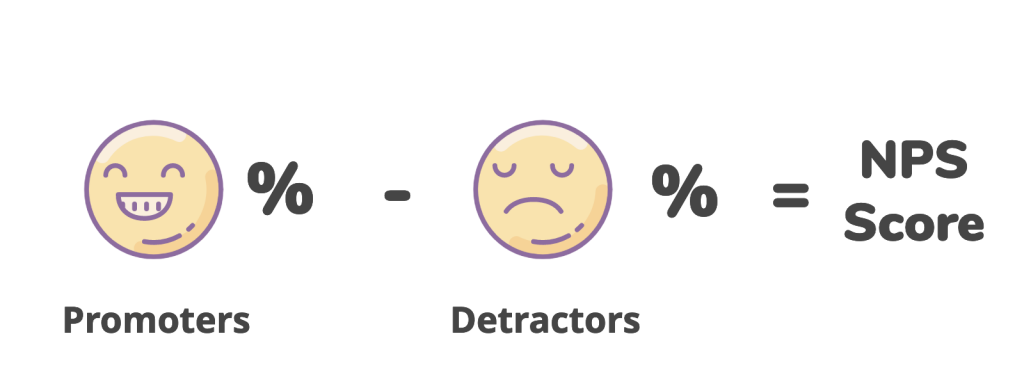
In other words, the NPS score reveals the difference between the number of detractors vs. promoters you have.
So, for example, let’s assume that your recent NPS survey revealed the following breakdown of your customer base:
- Promoters – 70%
- Passives – 15%
- Detractors – 15%.
Using the formula above, you can quickly subtract the percentage of detractors from the percentage of promoters and calculate your NPS score as 55.
What is a good NPS Score?
In general, any positive score is good. A positive NPS score suggests that your company is doing something right and that you have at least some loyal customers.
But there is more to this, of course. Here are some criteria to help you evaluate the NPS score:
- Any score below 0 surely signifies that something’s terribly wrong. There is no need to dig deeper, really. If you get a minus score, you know you have a problem.
- Scores between 0 and 30 are a good range. It doesn’t mean that you’re enjoying exceptional customer satisfaction, but at least you’re not doing something blatantly wrong. (Naturally, it also means that there is room for improvement.)
- Scores above 70 mean that customers love your company and are devoted to your product. At that level, a significant part of your overall growth should come from referrals.
What companies use NPS for?
One of the most amazing aspects of NPS is how universal it is.
NPS works for companies of all sizes. It doesn’t matter how big or small your business is, whether it sells products or provides services, or what industry you operate in; you can use NPS to measure customer satisfaction and predict its growth.
What’s more, you can measure almost anything with NPS. Apart from uncovering the overall customer satisfaction with your products and loyalty toward your brand, you can also use NPS to
- Research customer attitudes towards specific products, features, or capabilities.
- Evaluate different areas of the business – customer support, customer service, sales, etc.
- Review what customers think about specific locations or stores.
- You can even use it in employee feedback programs to measure employee sentiment through the Employee Net Promoter Score (eNPS).
With all this, you can:
- Evaluate your shoppers’ experience with your store or website.
- Find out whether software users enjoy using your product.
- Get a good idea about your chances of generating growth through referrals.
- Discover how satisfied your customers are after you’ve provided the service to them.
- Identify unhappy customers and reach out to them to try to change their attitudes (or at least learn what you could have done better.)
- Discover which customers are at risk of churning and more.
The benefits of measuring NPS scores
There are four main benefits of using NPS:
#1. NPS allows you to determine how loyal customers are to your brand.
The opposite is true too. NPS will also reveal how many dissatisfied customers you have and, in turn, how many customers might leave you.
Why is this important? One research after another proves that gaining new customers is more expensive than retaining the current ones. NPS helps you understand how much returning business you could expect and also what causes some customers not to want to do business with you anymore.
#2. NPS highlights where your company is falling short.
NPS might be a simple metric, but it carries with itself a breadth of knowledge about your business. All three customer categories – promoters, passives, and detractors – provide invaluable insights about your company with their scores.
Promoters tell you what you do well. The feedback from passives and detractors, on the other hand, reveals areas for improvement.
This is particularly helpful if you’re unsure about new initiatives in the business or new product direction. Insights from passives and detractors, particularly their answers to the NPS follow-up question, might shed light on the validity of your ideas (or tell you where your company is falling short, in general.)
That’s why I suggest you add an open-ended follow-up question to your NPS survey. This way, you’re allowing customers to provide additional context to their rating.
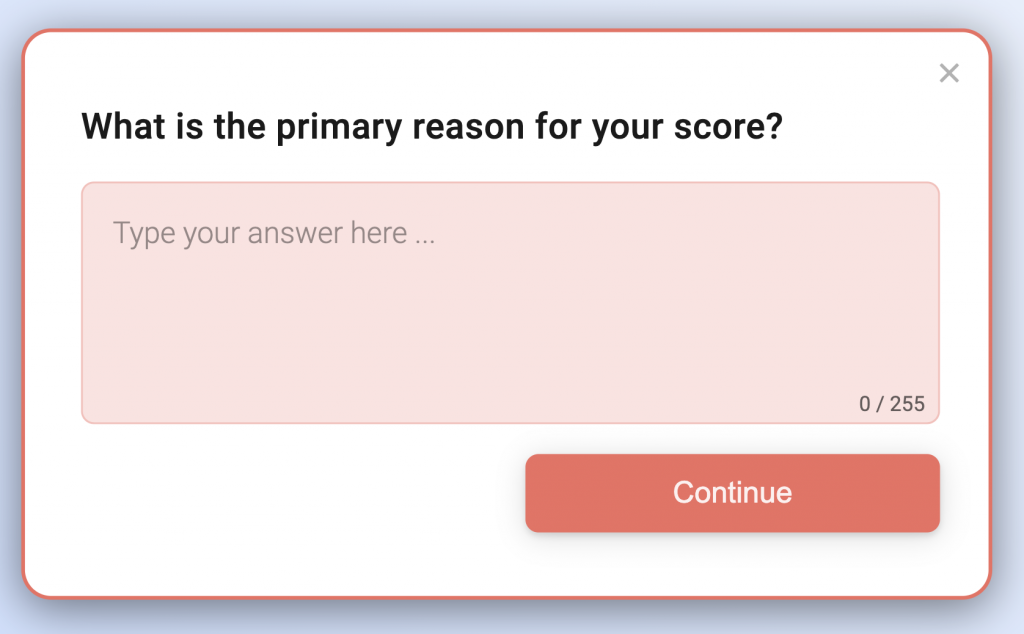
#3. NPS helps boost social proof and word-of-mouth
Interviewing detractors helps you learn more about your shortcomings. But engaging promoters might help you generate more social proof for your product and gain new referrals.
Promoters are absolutely enthusiastic about your brand, after all. They love your products or services, and many will admit that they can’t imagine life without them.
You can reach out to promoters and tap into their positive attitudes. Here are just some ideas on how to do it:
- Ask promoters to provide testimonials,
- Invite them to participate in customer case studies,
- Inquire if they’d be willing to share information about you on their social media profiles, etc.
Examples of NPS surveys
NPS is based on a simple, one question survey. But naturally, you can phrase that question in many different ways. You can inquire about the person’s attitudes towards your product in general. But you could also research their satisfaction with you based on their recent support interaction, or the buying experience.
In fact, I recommend that you run NPS regularly, and often send it after various interactions with your brand. Like these brands do, for example.
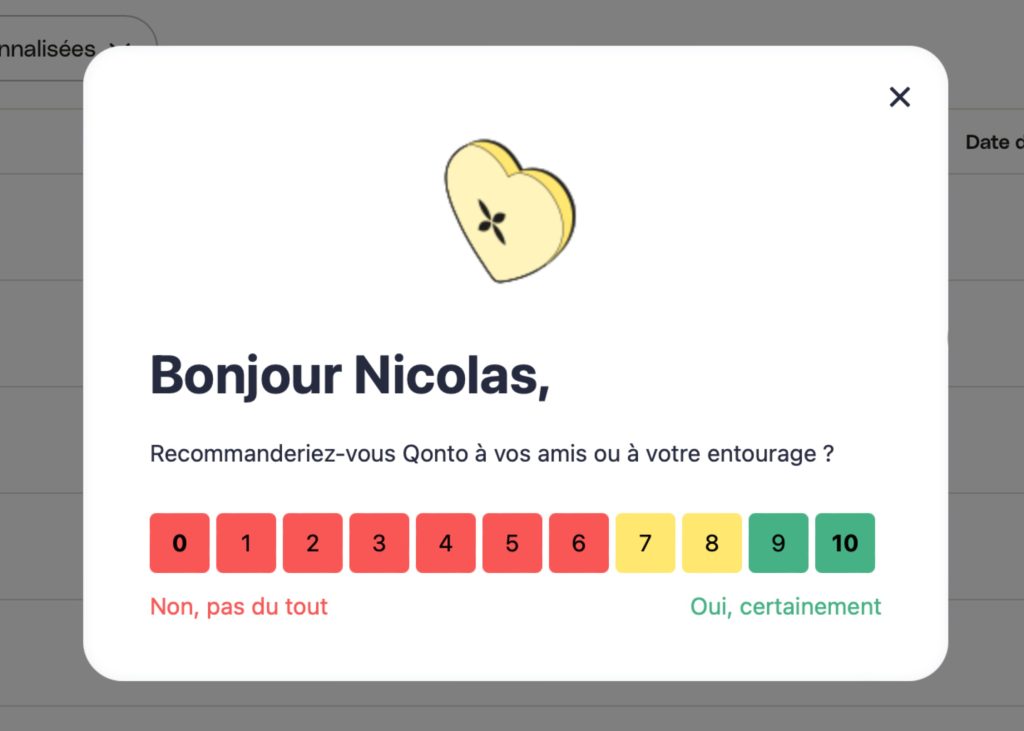
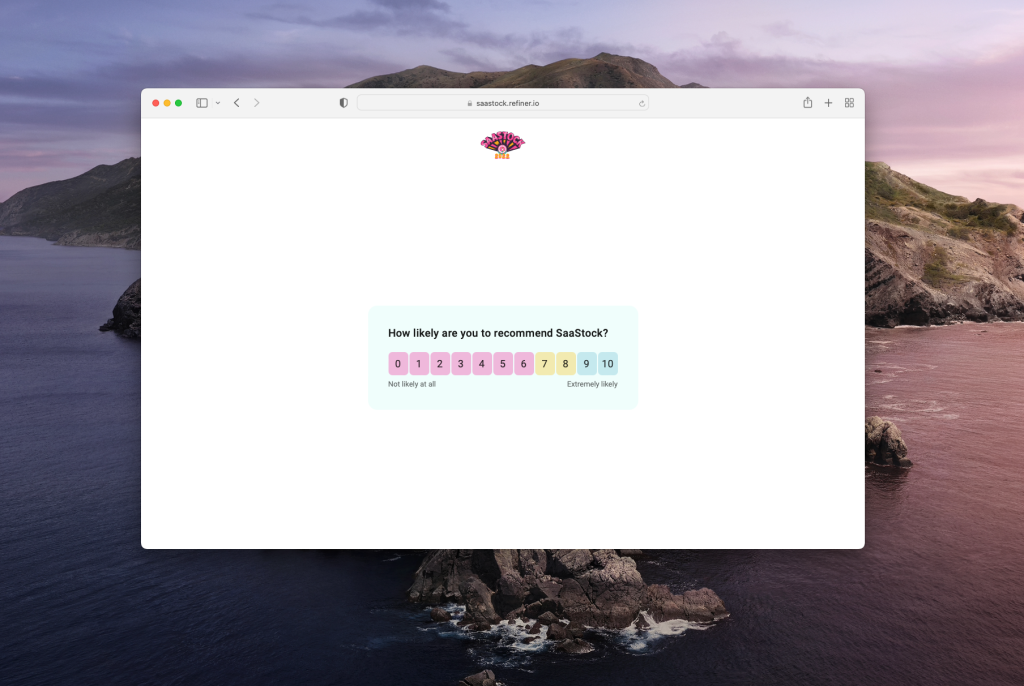
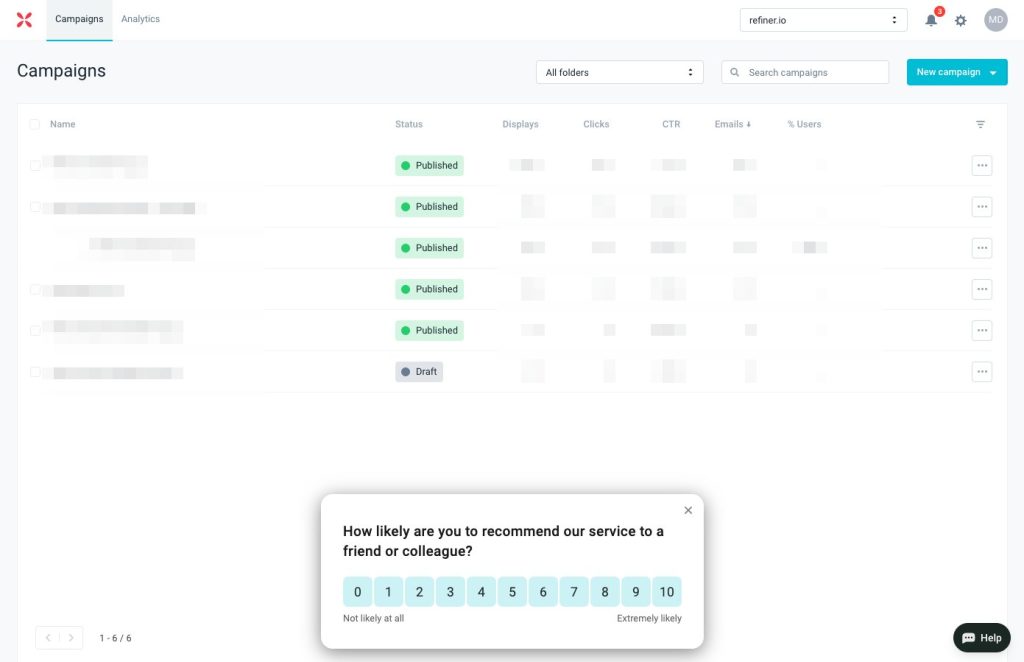
How to measure NPS score
NPS is based on a simple, one-question survey.
So, naturally, to collect NPS feedback, you need to present the question to your customers. There are several ways of doing it, actually, each using a different marketing channel to deliver your survey.
1. Email surveys
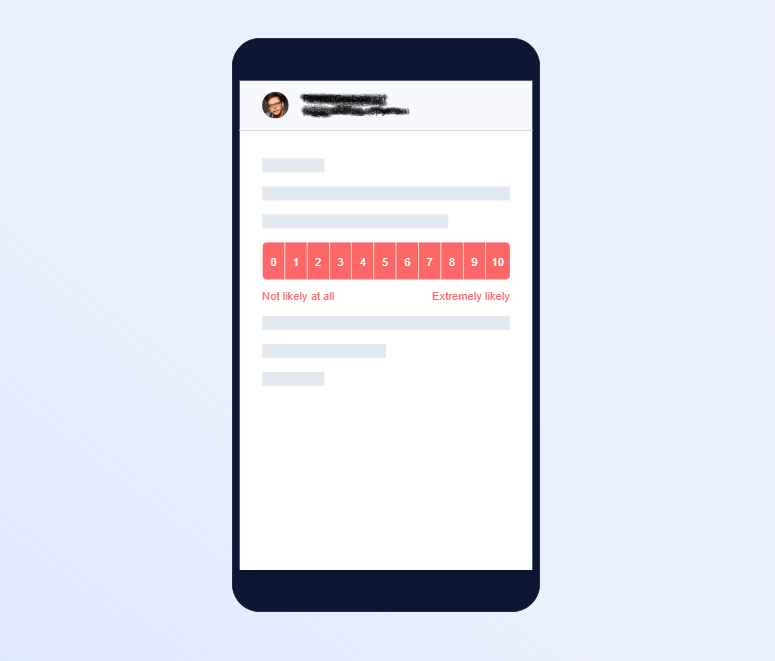
The first option is to send the NPS survey embedded in an email.
This method is ideal if you want to time the survey and invite customers to complete it after a particular interaction with your brand.
Email surveys reach customers as part of an email. When setting it up, your NPS software will output a piece of code that you need to include as part of the email template. Users will be able to initiate completing the survey in their email client but will be taken to a separate page to complete it.
2. Website widget
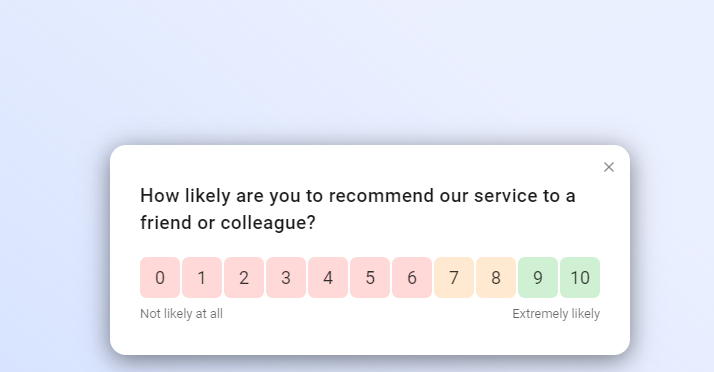
Alternatively, you can also display the survey as a pop-up widget on your website.
In this case, the survey will load on the user’s screen as they browse your site. In this method, you can target everyone who visits your site. Or you can use several methods to trigger the survey to specific visitors at a specific time only. You can even launch the survey widget on specific pages only or exclude it from being triggered on certain sections of the site.
3. Survey link

You can also distribute NPS surveys by sharing a survey link with customers. You can include the link in emails, live chat messages, social media, and countless other channels.
Anyone who clicks on the link will go directly to a survey page where they can provide their score.
How to use the NPS score to drive growth
NPS is not only universal in the sense that it works for all companies. It’s also universal because it can help you evaluate so many different aspects of your company’s operations too.
For example, you may discover that, on the whole, customers enjoy your product and find that it meets their needs. Based on NPS results, you can tell that the majority of them are either promoters or passives, with just a handful of detractors here and there.
At first sight, then, the situation is perfect. Maybe even more than you could hope for.
But, when you run NPS after customer support interactions, results look bleak. Turns out that your support aggravates dissatisfaction among customers.
Following up with detractors from that survey could provide you with further insights into what aspects of customer support to improve and how.
Running subsequent surveys can help you monitor whether your initiatives deliver the desired results and help improve customer attitudes toward your support.
Want to learn more about NPS?
Here are other guides to NPS we’ve published recently:
- How to calculate NPS score
- NPS vs CSAT: Which one to use
- What is a good NPS score
- What is an NPS detractor
- How to use NPS scores
- How to improve your NPS score
- Best questions to ask in an NPS survey









